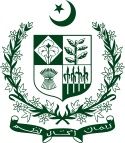National Assembly of Pakistan ایوانِ زیریں Aiwān-e-Zairīñ قومی اسمبلی Qọ̄mī Assembly | |
|---|---|
| 16th National Assembly of Pakistan | |
 | |
| Type | |
| Type | |
Term limits | 5 years |
| History | |
| Founded | 1973 |
| Leadership | |
| Structure | |
| Seats | 336 |
 | |
Political groups | Government (216)
Opposition (98) Suspended-Not alloted Reserved Seats (22)[a] |
| Elections | |
| Mixed member majoritarian | |
Last election | 8 February 2024 |
Next election | 2029 |
| Meeting place | |
 | |
| National Assembly Secretariat, Islamabad | |
| Website | |
| Official website | |
 |
|---|
|
|
The National Assembly of Pakistan (Urdu: ایوانِ زیریں, romanized: Aiwān-e-Zairīñ, IPA: [ɛːʋɑːn-e zɛːrĩː ˌpɑːkɪst̪ɑːn], lit. 'Lower house' or Urdu: قومی اسمبلی, romanized: Qọ̄mī Assembly) is the lower house of the bicameral Parliament of Pakistan, with the upper house being the Senate. As of 2023, the National Assembly has a maximum membership of 336, of which 266 are directly elected by an adult universal suffrage and a first-past-the-post system to represent their respective constituencies, while 60 are elected on reserved seats for women and religious minorities from all over the country. Members hold their seats for five years or until the house is dissolved by the President on the advice of the Prime Minister. The house convenes at the Parliament House, Red Zone, Islamabad.[4]
Members are elected through the first-past-the-post system under universal adult suffrage, representing electoral districts known as National Assembly constituencies. According to the constitution, the 70 seats reserved for women and religious minorities are allocated to the political parties according to their proportional representation.
Each National Assembly is formed for a five-year term, commencing from the date of the first sitting, after which it is automatically dissolved. The National Assembly can only be dissolved by the President of Pakistan on the Prime Minister of Pakistan advice, it cannot be dissolved by the Prime Minister alone.
On 3 April 2022, President of Pakistan Arif Alvi dissolved[5] the Assembly Under Section 58-I and 48-I on the advice of Prime Minister Imran Khan.[6] On 7 April, the Supreme Court of Pakistan set aside the dissolution order, restoring the National Assembly.[7] After these events, on 11 April, after National Assembly proceedings, a vote was held on deciding the next prime minister of Pakistan, overseen by Ayaz Sadiq. There were only two candidates contesting, from the PTI, was Shah Mehmood Qureshi, and from the PMLN, Shehbaz Sharif. Before the vote, 123 members of the PTI resigned from the National Assembly. The vote would be conducted under the supervision of Ayaz Sadiq, resulting in the election of Shehbaz Sharif as the Prime Minister of Pakistan. Following this, large political crises occurred across Pakistan in late 2022 and for the duration of 2023 between the ousted Imran Khan and Prime Minister Shehbaz Sharif until a new assembly was elected in early 2024.
The current National Assembly is the 16th National Assembly of Pakistan, which was formed in February 2024 after the 2024 Pakistani general election. The election was contested for rigging. The 16th assembly has seen various shuffles, including a large bloc of Independent politicians backed by PTI use the Sunni Ittehad Council as a parliamentary vehicle, and several reserved seats being suspended by the Supreme Court of Pakistan due to the Reserved seats case.
- ^ "Members". National Assembly of Pakistan. 15 April 2024. Archived from the original on 9 April 2024. Retrieved 15 April 2024.
- ^ "Ex-PM Khan's aide, Omar Ayub, appointed as opposition leader in Pakistan's National Assembly". Arab News. 2 April 2024. Retrieved 2 April 2024.
- ^ "After Senate, constitutional amendment passed in NA with two-thirds majority". Aaj TV. 21 October 2024. Retrieved 22 October 2024.
- ^ "Pakistan PM loses vital coalition partner as MQM quits". BBC News. 3 January 2011. Archived from the original on 10 June 2013. Retrieved 6 June 2013.
- ^ "President Alvi Dissolved National Assembly of Pakistan". Dawn. 3 April 2022. Archived from the original on 3 November 2022. Retrieved 3 April 2022.
- ^ "Imran Khan advises President to dissolve National Assembly". The Express Tribune. 3 April 2022. Archived from the original on 3 April 2022. Retrieved 3 April 2022.
- ^ "Supreme Court restores National Assembly, orders no-confidence vote to be held on Saturday". 7 April 2022. Archived from the original on 14 April 2022. Retrieved 7 April 2022.
Cite error: There are <ref group=lower-alpha> tags or {{efn}} templates on this page, but the references will not show without a {{reflist|group=lower-alpha}} template or {{notelist}} template (see the help page).

